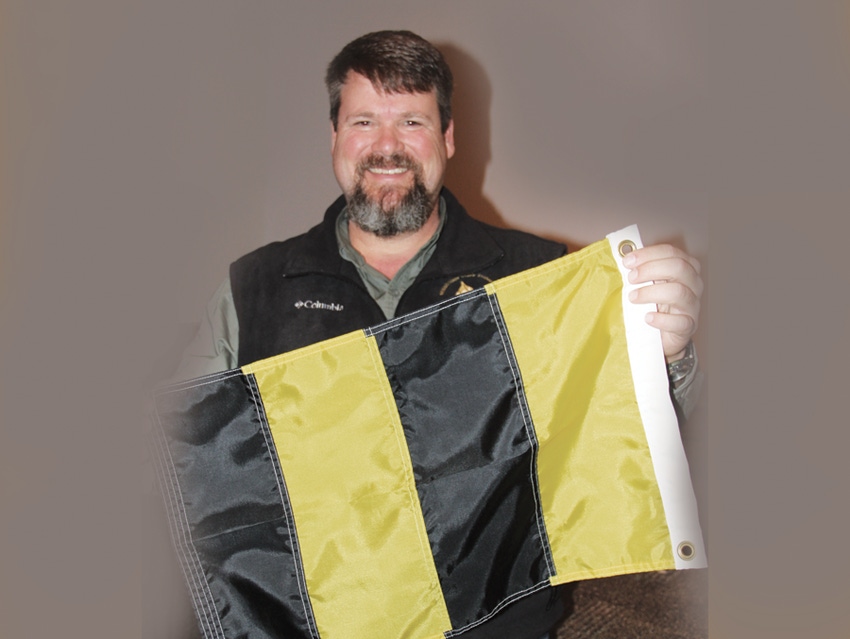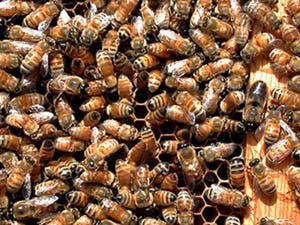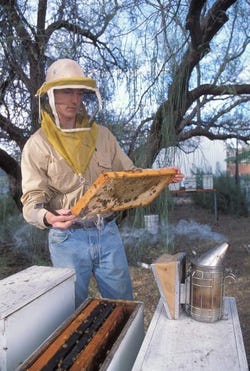
Protecting pollinators: Mississippi organizations develop guidelines
“Communication between parties is going to be extremely important,” says Angus Catchot, Mississippi State University Extension professor of entomology, of a cooperative agreement by beekeepers and agricultural organizations to protect honeybees and other pollinator insects. “In many cases," he says, "farmers and beekeepers don’t really talk to each other about what’s going on. They need to work together on choosing sites for hives — the farmer knows his land, and where hives are least likely to be sprayed."

Mississippi agricultural interests are taking proactive measures to adopt practices that will help to protect honeybees and other pollinators, which have been in the spotlight as result of concerns about the impact of pesticides on those populations.
The effort includes the development of a cooperative Mississippi Honeybee Stewardship Program and a distinctive flag that can be used to mark the location of hives in or near crop fields.

RANDY KNIGHT
The concern about pollinator insects following a widely-publicized two-year moratorium on use of neonicotinoid insecticide in Europe, and calls by activist groups for a similar ban in the U.S., has become “a very serious issue for our agriculture,” says Randy Knight, president of the Mississippi Farm Bureau Federation, who discussed the effort at the annual meeting of the Mississippi Agricultural Consultants Association at Mississippi State University.
“In an effort to be proactive on this issue, we arranged several meetings with the Mississippi Beekeepers Association, the Mississippi Agricultural Aviation Association, the Mississippi Agricultural Consultants Association, the Mississippi Department of Agriculture and Commerce, the Mississippi State University Extension Service, and row crop farmers.
“Our goal,” Knight says, “was to develop a plan in which all parties recognize the need to coexist, and to outline some basic standards on how to achieve a cooperative relationship that will minimize any adverse effects to beekeepers and at the same time not put farmers at risk of yield loss.”
Ag news delivered daily to your inbox: Subscribe to Delta Farm Press Daily.
The discussions led to the Mississippi Bee Stewardship Program, which was rolled out recently. The two-page document includes basic cooperative standards agreed to by the various parties.
(Read the entire document Mississippi Honey Bee Stewardship Program.)
An additional component of the program, Knight says, is a ‘Bee Aware’ flag, “which we hope will become so commonplace that no one in agriculture will ever pass one in a field a without thinking about the presence of bees. We hope these flags will be a tool to encourage producers to take precautions when performing any activity that might be detrimental to hives.”
The stewardship program “will create a very important foundation for problem-solving at the local level through education and stewardship,” Knight says.
“Our next step is to develop a brochure/flyer/communication piece that we will promote to Mississippi beekeepers, row crop producers, and other stakeholders and begin this awareness effort. To succeed, this will need the support of everyone in agriculture.
“We hope this will be a widely adopted and that we can use it as a demonstration to the EPA of the cooperation that can exist between beekeepers and farmers to better protect our bee populations, as opposed to proposing more and more label restrictions on products that we need for our crop production systems.
“Promoting the importance of this program will be another priority for Farm Bureau this year,” Knight says.
Andy Whittington, MFBF environmental programs coordinator, has recently been appointed to serve on the EPA’s Pesticide Policy Dialogue Committee, and will also represent the American Farm Bureau Federation in this dialogue.
Neonicotonoids in Europe
The neonicotinoid controversy surfaced in Europe a few years ago, and following the moratorium on those materials, has received a lot of attention in the U.S., says Angus Catchot, Mississippi State University Extension professor, who also spoke at the consultants’ conference.
“There is a lot of information — and misinformation —about this floating around in the social media, and it’s rampant on the Internet,” he says. “Unfortunately, it has given voice to a lot of people who have no scientific knowledge or expertise — they can say something on Twitter or Facebook and instantly have the same credibility as someone who’s an expert on the subject.”
Following the European Union action to put a two-year moratorium on neonicotinoids, there has been “a lot of pressure in the U.S. to follow the European model,” he says.
“You can’t believe how many people are now involved in this.
“The neonictinoid issue isn’t so much a problem in the South as in the Midwest, where there is wall-to-wall corn and not that much habitat for bees,” Catchot says. “But, this is an issue that is going to affect farmers everywhere.”
While there have been media stories in Europe about neonicotinoid dust clouds from farm fields at planting, he says, the problem isn’t so much dust from soil, but rather from lubricants on seed — mainly graphites and talcs.
“These lubricants get coated with the neonicotinoids that are on the seed and then they’re blown out of the exhaust from air planters. Canada has just banned the use of talc and graphite on seed.
“In tests we’ve conducted here in Mississippi, we were able to validate these claims. Traces of neonic-contaminated lubricant are, in fact, drifting downwind and settling on wildflowers where bees may be foraging. We were able to reduce this by using an experimental seed lubricant.
“We’ve also been investigating just how many bees are in the crops we grow in Mississippi and what time of day they are present,” Catchot says. “Bees aren’t as much of a factor in pollinating our corn, cotton, soybeans, which are self-pollinating. Still, there are bees in the fields and many beekeepers rely on these crops in our area to sustain their hives.
“To date, our findings would indicate that bees are only a factor when crops are flowering — and soybeans, by far, have more bees per acre during that period than cotton and corn.
“Although not part of the study, we have observed numerous bees in grain sorghum fields during the flowering period and are actively advising our clientele at farm meetings to avoid pesticide applications when bees are most active.”
To determine that, he says, “We have initiated time-of-day studies across the Mid-south to verify peak activity in our major row crops. Our preliminary results indicate that most bees will be in the crops from 10 a.m. until 3:00 p.m. The fewest bees were noted in the morning and evening.
“If we can move our crop spraying until later in the evening, then we have the entire night and most of the next morning for the residual to wear off before bees start foraging again. This will make a tremendous difference in acute bee kills, which is a problem at times because of the high spray environment in the Mid-South cropping region.”
Cooperative agreement developed
In the process of developing the stewardship program, Catchot says, “We’ve had a lot of meetings with beekeepers, USDA, farmers, ag aviators, and others — all the interest groups have had a seat at the table. The Mississippi Farm Bureau Federation has been instrumental in bringing everyone together and in developing the cooperative agreement and some best management practices.
“This isn’t law, it isn’t binding — it’s completely voluntary — but it incorporates measures we believe will protect these pollinators. It has been adopted by the Mississippi Beekeepers Association, and we think it could become the model for bee stewardship efforts across the U.S.”
The Mississippi groups, Catchot says, are “trying to show the EPA and the rest of the world that there are many things that can be done locally without mandates from the government. We’re going to use this as a benchmark for cooperatively dealing with the problem and showing that beekeepers and row crop farmers can coexist.”
In talking with farmers, he says, “Most just haven’t been aware of this issue. There has been almost no communication by beekeepers with farmers about bee kills, and many ag aviators haven’t been aware of the problem. They say they are completely willing to cooperate in bee protection efforts, but that beekeepers need to be more forthcoming about hive locations.
“We would like for beekeepers to provide GPS coordinates for locations of their hives,” Catchot says, “but they are quite competitive about sites for their hives, and there has been some resistance to this. The ag aviators maintain a database of sensitive areas, and GPS locations can help them to avoid spraying near hives.”
Beekeepers are also being asked to put weatherproof labels on their hives that show contact information, Catchot says, and to provide maps of hive locations. “The farmer should also have the beekeeper’s cell phone number, so he can let the beekeeper know when applications will be made.
“Communication between parties is going to be extremely important,” he says. “In many cases, farmers and beekeepers don’t really talk to each other about what’s going on. They need to work together on choosing sites for hives — the farmer knows his land, and where hives are least likely to be sprayed.
“Too often, we see hives right on the side of turnrows, where they’re likely to be sprayed or drifted on at some point. We know that bees forage up to 2 miles routinely, so why not move hives 100 yards or so off the field?”
Farmers will be encouraged to talk with their employees about bees and the need to avoid hives when making applications,” Catchot says.
One tool that will be used to increase awareness of hive locations is the “Bee Aware” flag that has been developed by the Mississippi Farm Bureau Federation.
“These will be distributed to beekeepers to place near hives,” Catchot says, “so everyone working in the field will see the flag and be aware that hives are nearby and need to be protected. We put information about this flag on our blog, and we’ve had calls from around the nation about it. We believe it will be a valuable tool.
“The ‘Bee Aware’ program is a major educational effort, to help make farmers, beekeepers, aerial applicators, and others aware of the issue and to encourage their participation in protecting these pollinators.”
In discussions with the Mississippi Farm Bureau Federation, Catchot says, “We need to start thinking outside the box on this issue. The new farm bill is loaded with conservation incentives. What if a farm bill rewarded conservation of bees? What if growers of self-pollinated crops (who have don’t require the service of commercial pollinators) were identified as “bee friendly” farmers and were rewarded by steps they agreed to take to go the extra mile in improving pollinator health on their farm?
“This would provide financial incentive to do even more. These may sound like pie in the sky ideas, but I believe the case could be made.”
In summary, Catchot says, “There is so much that can be done through educational efforts. I have been pleasantly surprised at just how supportive our row crop farmers have been since this issue has been brought to their attention.
“Moving forward, coexistence is key, and that will start through education and awareness. Several years ago, I never would have thought that I would be talking about bee safety on turnrows or at farmer meetings — but I am now.”
About the Author(s)
You May Also Like



